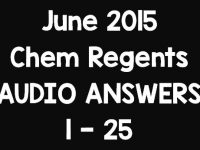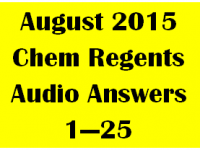75 Old and Hard Regents Questions

Below are the 75 most missed questions from recent regents exams 1. In the wave-mechanical model, an orbital is a region of space in an atom where there is (1) a high probability of finding an electron (2)…
Read More »June 2015 51 to 85

See a Question that you don’t get yet? Click on the question, and a short video answer pops open. Watch it, twice maybe; turn on your SOUND now.
Read More »June 2015 1-25

See a Question that you don’t get yet? Click on the question, and a short video answer pops open. Watch it, twice maybe; turn on your SOUND now.
Read More »June 2015 26-50

See a Question that you don’t get yet? Click on the question, and a short video answer pops open. Watch it, twice maybe; turn on your SOUND now. …
Read More »Regents Prep

Mrs. O’Donnell’s Regents Review Slides (worth a look) Crazy Errors from June 2015 exam explained June 2013 Parts 2+3 Questions and Answers Caitlyn’s Study Guide for the Regents Exam 75 Most Missed Regents Questions 75 Answers 100…
Read More »Nuclear Chemistry

Nuclear Basics Nuclear Slideshow Nuclear Notes Nuclear Chem Homework Assignments 100 Nuclear Chem Questions 100 Nuclear Chem Answers The main points of Nuclear…
Read More »Redox Electrochemistry

Important Dates to Remember Free Tutoring at Vestal Library Mon June 12 – 5:30 – 8:00 Free Tutoring at Vestal Library Tues June 13 – 5:30 – 8:00 Free Tutoring at Vestal Library Thur June 15 – 5:30…
Read More »Organic Chemistry

Organic Chem Slideshow Part 1 Organic Chem Slideshow Part 2 Organic PACK – Notes and BASICS Organic Chem Classwork Organic Chem Homework Organic Chem Review Slides (for Celebration Study)
Read More »Acids and Bases

Acid Base Slideshow Acid Base PACK – notes and BASICS Titration Practice Classwork Handout – Slide Show INTRO Acid Base Indicators Handout (print white paper – before color chase) Acid Base Color Chase Lab Acid Base Titration…
Read More »